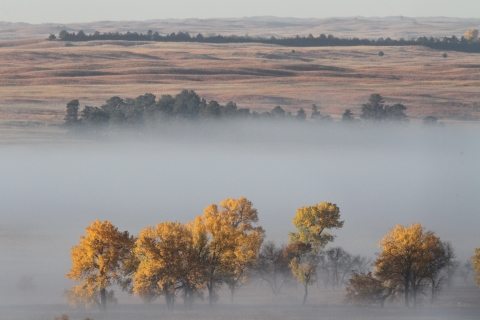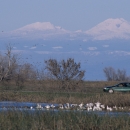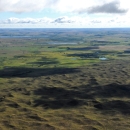About Us
Fort Niobrara Refuge, established in 1912, is located on the northern edge of the Nebraska Sandhills along the Niobrara River with a total of 19,131 acres. An unusual mix of topography, soils, and rock formations along with differing exposures to sun, wind, and moisture creates a rich diversity of plants and animals. Forests and riparian riparian
Definition of riparian habitat or riparian areas.
Learn more about riparian areas (habitat bordering streams, lakes, wetlands) border the river; conifer forests grow on drier hillsides and canyon slopes; and mixed-grass prairie is found on the tablelands north of the river and sand hills to the south. Sharp-tailed grouse, greater prairie chickens, and a variety of migratory birds thrive on the Refuge along with bison, other resident mammals, reptiles, and amphibians.
In 1960, a 200 acre stand of Ponderosa pine in the northern portion of the Refuge was designated as a Research Natural Area; and in 1976, approximately 4,635 acres in the northern portion of the Refuge, including the Niobrara River corridor, was designated as Nebraska’s first Wilderness Area. In 1982, five miles of the Niobrara River on the Refuge was designated as a National Canoe Trail, and in 1991, a total of 76 miles of the Niobrara River including the entire stretch of River through the Refuge was designated by Congress as a Scenic River.
Our Mission
Refuge Purpose(s)
Each unit of the National Wildlife Refuge System is established to conserve native species dependent on its lands and waters. All activities on those acres are reviewed to ensure they are compatible with the Refuge purpose. In the early 1900s, private conservation organizations were becoming increasingly concerned with the decline of wildlife populations and the loss of habitats throughout the United States. As a result of this concern a conservation legacy began within the establishment of multiple national wildlife refuges.
Fort Niobrara Refuge became part of this conservation legacy when an Executive Order, signed on January 11, 1912, established Fort Niobrara Refuge as a "preserve and breeding ground for native birds".
Our History
Refuge Establishment
The Refuge supports an wide diversity of plants and wildlife representative of the northern Great Plains. In the early 1900s, President Theodore Roosevelt and private conservation organizations, such as the National Audubon Society and American Bison Society, were becoming increasingly concerned with the exploitation of wildlife and their habitats on the Great Plains and elsewhere.
Fort Niobrara National Wildlife Refuge was established first on January 11, 1912, by President William Taft as a “preserve and breeding ground for native birds.” At this time the lands and waters totaled 13,279 acres set aside for wildlife. The Refuge was established at a time when tremendous concern existed due to over-harvest of birds and the near extinction of bison. Two groups, National Association of Audubon Societies and American Bison Society, were very influential in the establishment and helped determine the purpose of several Federal parks and refuges including Fort Niobrara during the first two decades of the 20th century.
The National Association of Audubon Societies was formed in 1905 and its first president, William Dutcher, was a friend of U.S. President Theodore Roosevelt. Numerous correspondence was exchanged between them regarding over-harvest of birds and the need to establish sites (refuges) to protect birds and game animals including the area around Valentine, Nebraska. The American Bison Society, headed by Dr. William Hornaday, was directly responsible for establishing Wichita Mountains National Wildlife Refuge in Oklahoma, National Bison Range in Montana, and Wind Cave National Park in South Dakota for the preservation of bison in the early 1900’s and was instrumental in bringing bison to Fort Niobrara.
Fort Niobrara Refuge was expanded by Executive Orders in 1920 and 1936, through the Resettlement Administration, subsequent purchases from private individuals, and a donation from the Nebraska Public Power District bringing the Refuge’s total acreage to 19,131. The expansion in 1920 was to protect and provide winter roost sites for sharp-tailed grouse and prairie chickens, and tracts of land acquired in 1936 were for migratory birds and pronghorn antelope management.
As recognition grew for this unique and important wildlife area, more acres and additional protections and designations were added to the Refuge. In 1960, a 200 acre stand of Ponderosa pine forest in the northern portion of the Refuge was designated as a Research Natural Area and in 1976, approximately 4,635 acres in the northern portion of the Refuge, including the Niobrara River corridor, was designated as Nebraska’s first Wilderness Area. In 1991, the beautiful Niobrara River received an important honor - 76 miles of the Niobrara River including the entire stretch of River through the Refuge was designated by Congress as a Wild and Scenic River.
History of the Landscape
The land and water of Fort Niobrara National Wildlife Refuge have sustained a rich diversity of wildlife for thousands of years. Fossils from more than 20 extinct mammal species, including the long-jawed mastodon, giant bison, and three-toed horse, have been unearthed on the Refuge. These animals roamed the area from 13 million years ago through the last ice age, about 12,000 years ago.
Two centuries ago, the Refuge and surrounding area was a sea of grass, unbroken except for wooded streams and rivers. Low rainfall, sandy soil, periodic fires, and high winds limited the establishment of trees and the growth of some grasses. Magnificent herds of bison and elk inhabited the area along with sharp-tailed grouse, prairie chickens, prairie dogs, wolves, mountain lions, grizzly bears, and other wildlife. Native Americans followed the bison herds, using them to meet their food, clothing, shelter, and spiritual needs.
Other Facilities in this Complex
Lacreek Refuge lies in the shallow Lake Creek valley on the northern edge of the Nebraska Sandhills and includes 16,410 acres of native sandhills, sub-irrigated meadows, impounded fresh water marshes, and tall and mixed grass prairie uplands. The Refuge serves as an important staging area for migrating waterfowl, sandhill cranes, shorebirds, and neotropical migrants. The Refuge provides critical wintering habitat for the High Plains trumpeter swan population.
Valentine Refuge is 71,516 acres and is located in the Sandhills of north-central Nebraska. The Refuge is a unique and important natural area of the National Wildlife Refuge System which includes more than 566 National Wildlife Refuges spanning approximately 100 million acres of lands and 750 million acres of oceans in the United States. The native prairie and wetlands found here support a diversity of wildlife. Little has changed from historic times. The Refuge was established by Congress in 1935 “as a breeding ground for migratory birds and other wildlife” and is home to 270 species of birds, 59 species of mammals, and 22 species of reptiles and amphibians.
Crescent Lake Refuge lies on the southwestern edge of the Nebraska Sandhills, the largest sand dune in the Western Hemisphere. The Sandhills are characterized by rolling, vegetated hills and interdunal valleys. These habitats on the Refuge are interspersed with 21 wetland complexes—shallow lakes, marshes, seasonal wetlands, wet meadows, and a small stream. Wildlife diversity, except large ungulates and their predators, is relatively unchanged since early settlement.
North Platte Refuge was established in 1916 by Executive Order No. 2446 as a “preserve and breeding ground for native birds.” It is located in the Nebraska Panhandle, near Scottsbluff. It was declared a National Wildlife Refuge primarily because of fall concentrations of up to 250,000 Mallards, 11,000 Canada Geese and Bald Eagles.
John W. and Louise Seier Refuge is found in north-central Nebraska, as a protected place for wildlife among the Sandhills. The Sandhills region is the largest remaining tract of mixed and tall grass prairie in North America. The Seier Ranch was originally homesteaded by John and Louise Seier’s grandparents in the mid-1800's. John and Louise Seier did not have any immediate family, but did have a love of wildlife and an interest in preserving wildlife, they donated, their 2,400 acre working cattle ranch to U.S. Fish and Wildlife Service in October of 1999. Because the Refuge is new to the System, it remains closed to the public at this time. There is no projected date for the opening of the Refuge, however, a date will be established upon the completion of a management plan.






